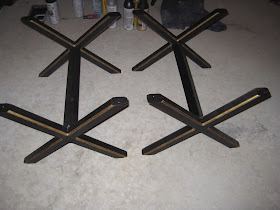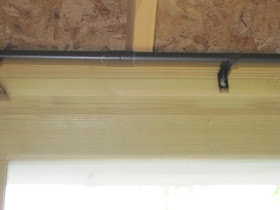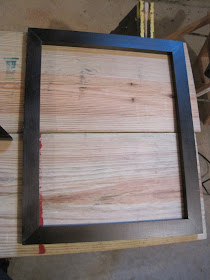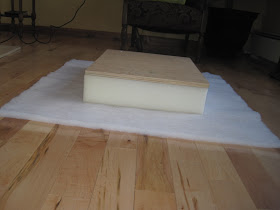My hubby and I decided to finally move forward with a DIY project we have been wanting to do. I was so inspired by a tutorial over at
Chronicles of Home on how to make an x-leg bench. It's a great, detailed tutorial, and exactly what I was envisioning for my living room. My living room is a bit on the formal side, so I wanted to dress the x-leg bench(s) up a bit! This was my inspiration:

Source: House Beautiful
Aren't these just beautiful! They are so rich, and I knew they would look lovely in my living room, which has chocolate velvet curtain panels, and rich burgundy, black and gold accents. The first step was to determine the height, length and width. Jennifer over at Chronicles of Home made her x-leg bench 17" square, however, I wanted mine to be rectangular as opposed to square. So the dimensions I settled on were 17" deep x 22 inches long x 17" high. I also wanted two benches, just like the photo above, so to pair them together.
So, we basically followed the tutorial, except we made the bench slightly longer, which doesn't change the angles or measurements given over at Chronicles of Home. The only change would be the long piece that connects the two X's together at the center. More on that in a bit!
My hubby sketched out the plan on paper and then took a quick trip to Home Depot. He ended up getting six 10 ft. lengths of maple 1x2's. We opted to get maple as it's a great hard wood, but you could also get it in other wood grades. What you choose will determine the cost. The maple was a bit pricey!
Here are all the pieces cut.
Next, sand down all the pieces! Then place one of the longer pieces on the ground, and lay one of the shorter pieces on top, making sure to line up the ends, and ensure that the angles are going in the same direction. Apply wood glue to the bottom side of the smaller piece and press into place on top of the
longer piece, making sure everything is perfectly aligned.
Lay another long piece on top, perpendicular to the shorter piece. Again, gluing those pieces together and aligning them properly. Wipe off any excess glue and after 15 mins. or so check them to make sure everything is still aligned.
Do this same thing with the other two long pieces and the short
pieces. Let the glue set up for 30-60 minutes, then carefully turn the glued
X's over and follow the same process with the remaining four short pieces. They should look like this.
My hubby used clamps to keep the pieces in place while the glue dried.

Viola!

Next, you must put a touch of glue in the center notch where the two pieces fit together. Let the glue completely dry, then hammer three 1 1/4" finishing nails down each length of the shorter pieces.
Now, here's where I deviated a bit from the tutorial over at Chronicles of Home. If you remember my inspiration piece:

You will see the beautiful gold accents on the legs and then the gold that wraps around the base of the cushioned seat. Well, to get that look, my hubby used his router along the outside and inside edges of the X-legs, front and back, to create an indentation (a guide, if you will) for me to paint gold. He used a 3/16th inch beading router bit. The only area he didn't router was the top of the X, closest to where the cushioned seat would be.



Doesn't that give it such a beautiful, finished look!
As you can see from the photo below, we then put some wood putty over the nail holes, allowed that to dry, and then sanded them down.
Before we went any further, we spray painted the X legs with Rustoleum's Oil Rubbed Bronze.
Next, we cut our center piece, which connects the two X-leg bases together. Remember, you need to cut two pieces and glue them together, much like we did the X-legs. We cut these pieces 17 3/4 inches long. I had mentioned earlier that the length of this piece did differ from the dimensions given at Chronicles of Home, because we opted to have our benches be longer than 17". To achieve a 22" long bench our center piece, again, was cut at 17 3/4" long. Once cut, we glued both pieces together, waited for the glue to drive, then nailed it several times, and puttied over the holes. Once dry, we spray painted that with Rustoleum's Oil Rubbed Bronze. Once dry, lay one of the X's on the floor and put a dab of wood glue in the center.
Position the center piece in the center, upright, and let it dry for 30-60 minutes.
When we did this, the glue was unable to actually hold the center piece in place. My hubby ended up driving a screw right in the center of the X from the outside, on both X's, to hold the center piece in place. We wondered if the glue didn't adhere/hold the center piece due to the fact that the wood had been painted. Perhaps, if we were to do this project again, we would wait until the legs were fully assembled before painting them. We puttied over the screws and spray painted once again, and then used Rub-N-Buff in Gold Leaf to paint the areas that were routered. I found it easiest to use a very small and fine, yet somewhat stiff paintbrush to paint the routered areas. Here's how they looked after that step:

If you look at our inspiration photo, you will notice that those benches have a wooden piece, painted gold, between the X-leg base and the upholstered seat. This wraps all the way around the seat. To achieve this look my hubby cut two long pieces of 1"x 2" that were 22" inches long, and then two pieces that were 17" inches long. All of them were cut at 45 degree angles. He then glued them together like a picture frame. He has a picture frame clamp that works well for this step.
Here are all the pieces painted:
Since I wanted the sides of the "picture frame" to be gold, I used, once again, Rub-N-Buff's gold leaf paint.
I tried applying it with my finger, which according to the directions, is preferred, but I found the paint brush, worked better, and was a lot less messy. Allow for drying time in between, and then re-apply as many coats as is needed to cover the area. I think I painted 3 coats, and once the final coat was dry, I buffed it to get a shiny finish. The tricky part was ensuring that you didn't get any of the gold paint onto the Oil Rubbed Bronze Paint applied to the rest of the X-legs. I would be lying if I didn't admit that I had to do a few touch-up jobs, a few times, both the gold sections and the Oil Rubbed Bronze areas. It would have been easier to touch up the Oil Rubbed Bronze if it hadn't come from a spray can. I think, in the future, I would either paint the legs with reg. paint or stain them.

F.Y.I., you will want to apply some of the gold paint along the top of the "picture frame", as you want to ensure that none of the oil rubbed bronze paint shows through once you place the upholstered seat on top.
Once this was complete, the final step was to upholster the seat. We began with a 3/4" thick piece of plywood. Cut it 17" wide by 22" long. Then I purchased a 4" thick piece of foam. I made sure to buy a very firm piece of foam, where this was going to be a seat. A little helpful hint.........denser foam is easier to upholster, as there is less give! We cut the foam to the same dimensions of the plywood. I then laid batting down on the floor, cutting that to be about 10-12 inches wider and longer than the foam and plywood, to allow you to wrap the batting around to the back side of the plywood and staple it.
The next step was to cover it with a fabric of my choice. The hardest part for me was to find a fabric that I really liked, and one that would look nice in my formal living room. I ended up with a chocolate brown, suede-like fabric that I found at Joann Fabrics, for like $8/yd. I only needed 1 yard of 54" upholstery fabric.
I wrapped the fabric around the cushion, much like I did the batting. I didn't think to take pictures of that step, but Jennifer over at
Chronicles of Home gives an excellent and detailed tutorial on how to upholster the seat for this bench, so I won't bother and replicate that. Check it out.
Anyhow, once the cushion was upholstered, we turned the bench on it's top, with the cushion on the floor, and my hubby drove screws through the picture frame into the back of the plywood. Make sure it's lined up well before screwing it!
As you can see, he had a little helper. My youngest is obsessed with power tools. No worries, there's not drill bit in the drill!
Here's the end result.....what do ya think????








 in 1.5" width and 20 yards, which was roughly $7.00. They have so many colors available, varying width and lengths, and they are super affordable. I would highly recommend Ribbons and Bows Oh My! The great thing about using ribbon for the back tabs is you do not have to hem the sides, and the ribbon is very durable.
in 1.5" width and 20 yards, which was roughly $7.00. They have so many colors available, varying width and lengths, and they are super affordable. I would highly recommend Ribbons and Bows Oh My! The great thing about using ribbon for the back tabs is you do not have to hem the sides, and the ribbon is very durable. 




























